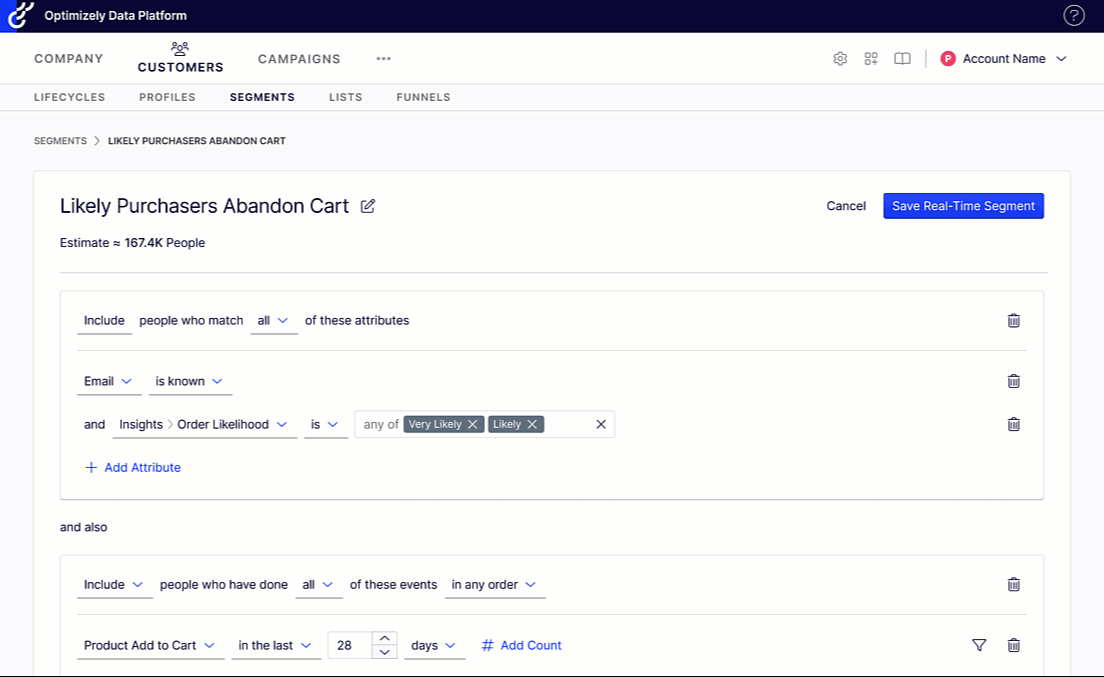Real-Time Segment Builder
Simplifying complex segmentation tooling with a flexible, intuitive user interface to support the creation of real-time audiences for web personalization.
ROLE
Product Designer
COMPANY
Optimizely
DATE
2021–2022
SKILLS
UX, Wireframing, Design Sprints, Iterative Design, Usability Testing, Prototyping, Systems Thinking

Background
Following the acquisition of Optimizely Data Platform (ODP), formerly Zaius, Optimizely aimed to enhance its segmentation capabilities to support new, real-time use cases. To do so, the company built on the success of Zaius’s original segment builder, which emphasized sentence-style configuration over technical complexity, with the goal of bringing that same clarity and usability to a next-generation, real-time segmentation experience.
The Real-Time Segment (RTS) Builder needed to do more than replicate the existing experience: it had to expand functionality to support live web personalization, integrate seamlessly with other tools in the ecosystem, and be visually adapted to Axiom, Optimizely's product design system.

Original Segment Builder
The project had been in motion for over two years, starting with backend beta testing and no front-end UI while at Zaius. As the legacy Zaius product designer, I referenced my prior experience working on the original segment builder as well as new and existing feedback to elevate and evolve this user experience.
“
Optimizely’s Data Platform stands out because it focuses not just on data collection, but on orchestration and activation. ... One of ODP’s best features is its segmentation engine. ... Need to create a segment of high-value users who browsed your headless CMS content but haven’t purchased in 30 days? Done in minutes.
KEVIN SCHOFIELD
VP, EXPERIMENTATION & OPTIMIZATION @ VELIR
Design Process
Early Exploration
Leading design on the Real-Time Segment Builder project, I began by iterating in low-fidelity, working closely with product management and engineers to clarify technical processes and edge cases. Additionally, I mapped out the underlying segmentation logic in FigJam to inform flows, clarify user interactions, and align cross-functional teams around system behaviors.
This phase helped uncover nuanced functionality needed to support real-time use cases, allowing me to move onto higher-fidelity exploration. Key challenges that followed included:
-
Balancing familiarity for legacy Zaius clients with new use cases and workflows.
-
Simplifying the interface while supporting complex logic.
-
Designing for eventual extensibility across the full Optimizely ecosystem.
Iterations & Alignment
To align stakeholders around next steps, I led a 3-day Real-Time Segments Workshop, a modified design sprint, involving Product, Engineering, and Marketing teams. We explored ways to support evolving segmentation logic, streamline user workflows, and identify where RTS should show up throughout the ecosystem.
In parallel, I iterated on high-fidelity designs balancing the use of legacy components with Axiom elements to support ambitious release timelines. I worked with the Optimizely product design team to critique the proposed experience and ensure accurate component alignment with platform-wide standards.
These collaborative processes directly informed design priorities, establishing alignment on MVP requirements, research goals, and future investments.
Usability Testing
Working with a UX researcher to recruit and facilitate, I crafted a test plan to validate the core MVP workflow. We tested high-fidelity prototypes with slight flow variations tailored to major client use cases: former Zaius clients, B2B Commerce users. B2C Commerce users, and Web Experimentation users.
Each participant was asked to build a segment and provide feedback on visual hierarchy, usability, and overall clarity. Participants were also shown different visual design options to gauge style preference—an area of internal debate among the design team. Insights from this research informed refinement of the MVP experience and influenced future-state concepts already in design consideration.
Support & Future Direction
Once MVP designs were validated and had begun development, I created additional RTS mocks to flesh out interaction details, such as input field behaviors and error states. I also designed follow-on features, including flexible condition grouping, nested logic, and a fully Axiom-compliant UI. This future-state vision served to guide iterative development and support stakeholder alignment on the long-term roadmap, which became implemented after my departure from Optimizely.
Impact
The Real-Time Segment Builder became a critical component in positioning Optimizely as a leader in data-driven personalization. By expanding a well-received interface to support complex, real-time use cases, RTS helped bridge the gap between traditional CRM segmentation and dynamic, behavior-based targeting.
More broadly, the project became a blueprint for integrating Optimizely Data Platform functionality into the larger Optimizely ecosystem. The attention to usability, design systems, and extensibility ensured RTS would continue to scale as a foundational capability in the platform's future roadmap.









